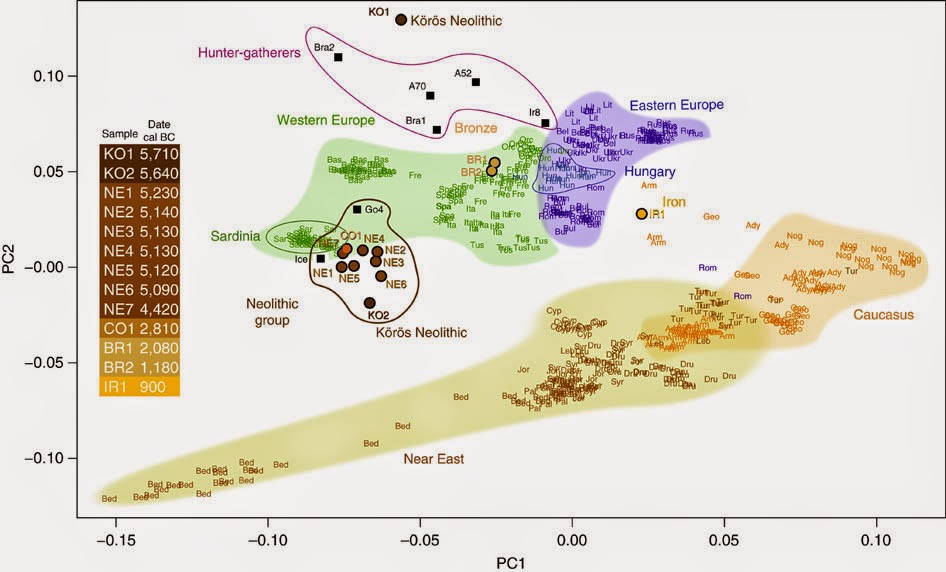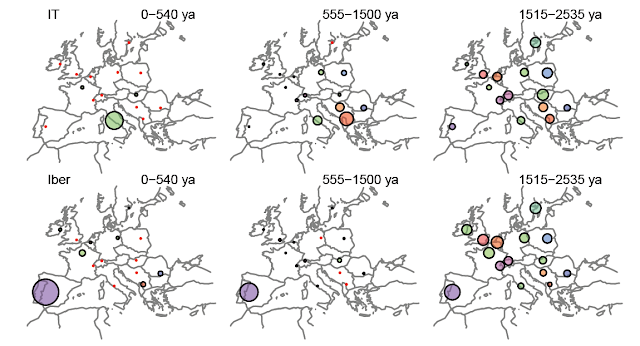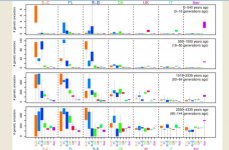Angela
Elite member
- Messages
- 21,823
- Reaction score
- 12,329
- Points
- 113
- Ethnic group
- Italian
Alan: How on earth could three so different Indo European groups (Greeks, Germanics and Celts) end up with deities who are equivalent to Hurrian Sky God Teshub, if they didn't originated near by or at least crossed the region at some point of history.
The only way I can see two groups of different linguistic background can end up with the same deities is if they influenced each other and therefore originated not too far from each.
So now, in addition to the Etruscans, the Greeks, Germanics and Celts also moved through Anatolia in the first millennium BC in order to reach Europe? That's what we're discussing, after all, not long standing ties between Anatolia and Europe. I don't want to derail this thread, but I thought it was pretty well settled that Celtic was present in Europe much earlier than that. I totally agree that if you have widely separated cultures which have a similar word for a similar type of "god", the ancestors of these people must have been in some sort of contact with one another at some point. However, that contact could have been trade, couldn't it, not necessarily that their ancestors were all living in adjoining valleys? Plus, the other really operative question is when were they in contact? I take Taranis' point that the specific word used by the Etruscans is close to the Luwian word. However, if they were close enough in space and time to adopt a Luwian word for this god, why didn't they speak Luwian? How do we know that they didn't adopt it just because of cultural or trade contacts? It just seems like a pretty minor bit of evidence...I can't see how it "seals the deal".
I had this question answered once. The thing here is we shouldn't expect modern Tuscans to be 100% descend of Etruscans. Maybe only 40% of modern Tuscans are. And we shouldn't take modern Anatolians as representative for ancients for that matter.
But thatn the fact that Tuscans are almost equal to Greeks and Albanians who are closer to Anatolia and therefore should naturally have more affinities to it, is also dubious. Why should Tuscans be like Albanians if they are further away from Anatolia?
Albania is right across the Adriatic from central Italy. At the times in question, prior to the Slavic migrations into the areas just north of Anatolia, "Albanian like" and "Greek like" people probably extended quite a bit further up the coast. At certain spots you can drive animals across the Adriatic. There has been gene flow across the Adriatic since time immemorial continuing into the present day. In fact, based on IBD segments, Ralph and Coop concluded that the Albanians are the only foreign group which had any type of significant impact on the Italian gene pool since about 400 BC. It surprised me too, but I haven't seen any paper refute those findings.
https://www.google.com/?gws_rd=ssl#...he+geography+of+recent+ancestry+across+europe
Plus, the Dutch and the eastern English are very similar too and they have the storm tossed and very dangerous British Channel between them and one population is actually south of the other. In addition, modern Tuscan samples are taken from people whose grandparents all come from the area. That's under 100 years. Look at the levels in southern Italy. It could have been diffusing up from the south for 2800 years.
Or look at PCA's. Tuscans are basically eastern shifted Sardinians, or said another way, Indo-European admixed Sardinians. Goodness, a Copper Age sample from Iberia was already pretty similar to modern day Tuscans.
http://www.eupedia.com/forum/thread...-Tuscans-not-Basque-or-Early-European-farmers

http://1.bp.blogspot.com/-xPGV13M4lSM/VEaknJoP-jI/AAAAAAAAJ0I/XmX-S48tr2A/s1600/ncomms6257-f2.jpg
You can also take a look at the Globe 13 spreadsheet from Dodecad. The Greeks from the northern mainland (Thessaly) are 23% "West Asian", while Tuscans are about 18% "West Asian". This is what causes some of the members of the Greek sample from Thessaly on PCAs to overlap the most "southern" Tuscans, and with the rest plotting to the south and east of them. Now, you're assuming that the two groups plot like that because the Tuscans got additional gene flow from Anatolia. Perhaps another question that should be asked is what happened to the genomes in northern Greece that might have lowered their "West Asian" percentages? Isn't the obvious answer that the Slavic migrations affected the genetic signature? To cite Ralph and Coop again, they show that impact on at least the mainland parts of Greece very clearly.
This is the link to Globe 13.
https://docs.google.com/spreadsheet/ccc?key=0ArAJcY18g2GadF9CLUJnTUdSbkVJaDR2UkRtUE9kaUE#gid=2
I'm not saying that there might not have been some elite migration from somewhere to the east, although I'd be more inclined to see it as coming from the northern Aegean rather than the middle of Anatolia. In that case at least there's a possibility that the people were speaking a pre-Greek language. In Anatolia, including Troy, everything I've seen would lead me to think those areas were Indo-European speaking. Even if it turns out that some sample in an elite grave comes out as identical to some "Lydian" sample of that periods, 40% replacement? I don't think there's any support for that in genetics or history. Where is the archaeological trail on the ground? For the Indo-Europeans we at least have all the kurgans going up the Danube and burned towns and fields in southeastern Europe. Plus, many of those areas were not very populated. There's none of that in central Italy, and it was also densely populated. Plus, as I pointed out, we have a Copper Age sample from Iberia that was already very "Tuscan" like.
Sorry, we're going to have to agree to disagree. None of you has persuaded me; I'm still an agnostic on this one.
Ed. To correct citation.
Last edited:


.png)


